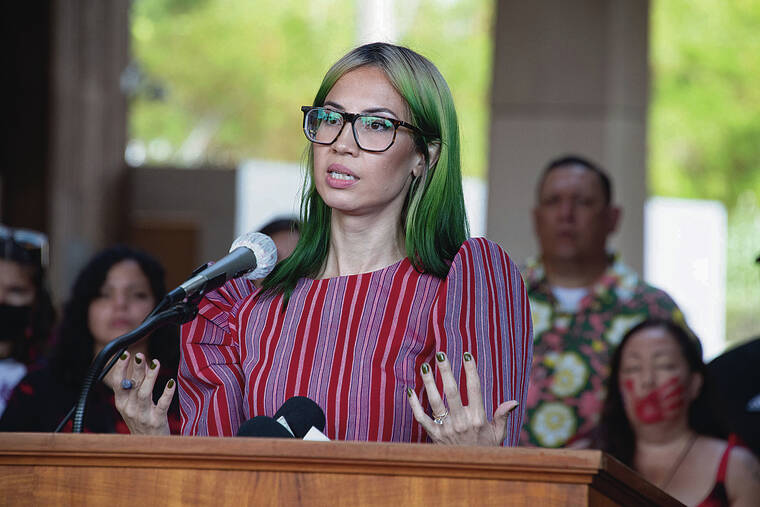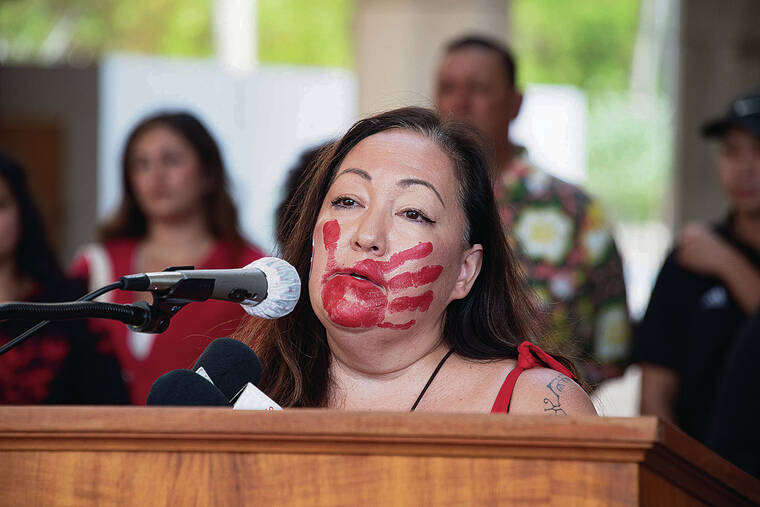Among the findings in a report released Wednesday by a task force created by the state Legislature last year, more than a quarter of missing girls in Hawaii are Native Hawaiian.
The Holoi a nalo Wahine ‘Oiwi report — the first of its kind undertaken by the Missing and Murdered Native Hawaiian Women and Girls Task Force — analyzes data from various social service agencies and other sources with the aim of better identifying causes behind issues like sex trafficking, sexual exploitation and domestic violence, which appear to affect disproportionate numbers of Native Hawaiian women and girls.
“The types of violence that lead to people being missing and murdered impact Native Hawaiians at rates much higher than other populations,” said the report’s lead investigator, Nikki Cristobal, at a press conference held Wednesday at the state Capitol. “It is my hope that we can use this report and subsequent reports to adapt our policies and practices to better protect our Native Hawaiian women and girls from further sexual exploitation and gender- based violence.”
>> Missing and Murdered Native Hawaiian Women and Girls Task Force Report Opens in a new tab
According to an Associated Press report, several states formed similar task force panels after a report by the Urban Indian Health Institute found that out of 5,700 cases of missing and slain Indigenous girls in dozens of U.S. cities in 2016, only 116 were logged in a Justice Department database.
Cristobal identified data collection as one of the biggest obstacles in moving forward with reform-minded efforts as public and private agencies don’t always collect statistics on race. And some data groups together Native Hawaiians and other Pacific Islanders, making it difficult to identify the degree to which Hawaii’s Indigenous people are affected. About 20% of the state’s population is Native Hawaiian.
“We need to be better across departments,” Cristobal said. “Specifically people in the military, police departments, Department of Health, all those major players. Being better at collecting racial and gender data that is disaggregated and having more accessible processes for sharing those datas for task force members like myself.”
Administered through the state Commission on the Status of Women and the Office of Hawaiian Affairs, the task force comprises individuals representing over 22 governmental and nongovernmental organizations across Hawaii that provide services related to violence against Native Hawaiians. Advocates and task force members attended the press conference dressed in red, symbolizing the blood of Indigenous women who are missing or murdered.
The 22-page report found that the missing and murdered Indigenous women and girl crisis documented in Canada and the mainland United States is also devastating Hawaii.
While Native Hawaiian females represent only 10.2% of the total population of Hawaii, more than a quarter of missing girls here are Native Hawaiian, according to the report. Also, the average profile of a missing child is a 15-year-old Native Hawaiian girl, missing on Oahu. Additionally, the report found that a majority of sex trafficking cases involved Native Hawaiian girls trafficked in Waikiki — and that 38% of arrests made for soliciting sex from 13-year-olds, through Operation Keiki Shield, have been active-duty military personnel.
“On one hand, these findings are startling,” said Khara Jabola-Carolus, executive director of the Commission on the Status of Women. “On the other hand, this report really doesn’t say anything new. Instead, it vindicates and validates what Native Hawaiians, sex trafficking and gender-based violence service providers and feminist activists have been saying all along.”
Jabola-Carolus, who serves as a co-chair of the task force and has advocated for women and girls in Hawaii for a decade, said she hopes the report will prompt more people to joint efforts to effectively address issues probed in the report. Advocate Dayna Shultz of the anti-violence organization Pouhana O Na Wahine said that change can even begin within one’s own family.
“At the end of the day, everyone has a part to play,” Shultz said. “Have these conversations. Do not be afraid to speak of it — because silence continues the shame.”
The 2022 report will be made available on OHA’s website as well as on the Commission on the Status of Women’s website.
———
The Associated Press contributed to this report. Linsey Dower covers ethnic and cultural affairs and is a corps member of Report for America, a national service organization that places journalists in local newsrooms to report on undercovered issues and communities.






